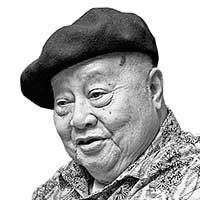Learning from Japan

I am 94. Looking back, I now realize that one of the most important projects I’ve undertaken was a Tagalog translation program for books on Japan. Thanks to Yoshiko Wakayama and Kazue Iwamoto, I received a Toyota Foundation grant for the program, which I managed with much enthusiasm.
I had always thought that there was so much we could learn from Japan, a country with a land area similar to ours but with much less land for cultivation. Like us, the Japanese were also a divided people until the 16th century, when Tokugawa Ieyasu united the warring clans.
The Meiji Restoration in 1886 is one of Asia’s major historical events in modern times. Promoted by no more than a hundred Japanese intellectuals, businessmen, and samurai, it modernized Japan in one generation to be the great nation that it has become.
Japan has scant resources and its greatest asset is its people – disciplined, purposeful, and very Japanese.
I went to Japan for the first time in 1955 when that country was still very poor. The scabs of war had not yet been fully lifted and ruins were still everywhere. I felt rich. The exchange rate for one dollar was two pesos or three hundred sixty yen. Some of the houses in the suburbs of Tokyo and Kyoto were still roofed with grass. Streetcars rumbled in Tokyo, and willow trees lined the Ginza.
Those sleek shinkansen were not yet on the drawing boards; the trains were powered by giant black locomotives. My first impressions of the country were the neatness of neighborhoods, a sense of order everywhere, hordes of men, almost all of them in similar dark suits, marching briskly to work.
Superior Japanese craftsmanship was also everywhere, in shops as well as in homes. On the top floor of department stores, folk products were on exhibit, together with the craftsmen doing their thing on wood, leather, or cloth. I had to visit a folk art museum to see other artifacts of Japanese craftsmanship, how, for instance, eggs are separately wrapped.
Such craftsmanship was transferred to the factory floor, and this explains the high quality of Japanese manufacturing today. If anything, this is one aspect of Japanese culture we can easily emulate.
I travelled around the country and met with young Japanese. As one who had experienced Japanese brutality during the three years of Japanese Occupation, I felt very uneasy on my first visit and I thought I would never have pleasant social contact with the Japanese. But through the years, I’ve made a lot of acquaintances, some of which have turned into very warm friendships and I got to know the Japanese on human terms. I never romanticized the country, however – I also got to know a little of its dark side.
The translation program was, in a sense, also a publishing experiment. I gathered about a dozen of our best writers in Tagalog and told them that their translations should be in the Tagalog of Manila, not the archaic Tagalog of Balagtas. It was also a challenge for them because these writers were Tagalistas; deep in their hearts they wanted a Tagalog that was pure.
I was thinking, however, of the thousands that could not understand that variety of Tagalog, particularly the non-Tagalogs who at the time were already acquiring the language very fast through mass media and forced Tagalog instruction in the schools.
I personally selected the books on Japan, some of them written by Japanese authors themselves. What I wanted readers to learn was how Japan, which was once a very poor nation, became so rich and powerful in such a short time.
For instance, in 1955, ten years after its defeat in World War II, Japan was still poor. But I knew it would develop very fast because an intellectual infrastructure was already in place. The Japanese were not only industrious, they were trained craftsmen from childhood onwards. More than anything, their sense of nation was formidable; it united them.
The editors of the Tagalog translations, Nora Dimagiba and Alain Padilla, were doubly careful. There could be errors, flaws in nuances. The translations were not from the original Japanese but from English.
One of the most interesting books that I selected for translation is the memoir of a doctor from Ibaraki, Memories of Silk and Straw. The doctor recounted his experiences, his patients that included geishas, samurai, the very rich, and the very poor farmers and fishermen whose footwear were made of straw, whose clothes in summer were the same that they wore in the coldest winter. The other books included studies on Japanese thought, social mores, literature, and the autobiography of the founder of Sony, Akio Morita.
I was able to have more than 60 books translated. Unfortunately, neither the Toyota Foundation nor my Solidaridad Publishing House profited financially from this innovative enterprise. Was the program far ahead of its time? The awful truth is Filipinos do not read. They look and listen, sometimes. Even today, the best books in Tagalog do not sell.
We were left with thousands of books in the bodega. The lifetime of a book is at the very least 50 years. Instead of having them rot, we donated them to the National Library, to the Department of Education, and to some schools.
Filipinos don’t throw books away, we keep old magazines and newspapers to sell. So all these books, if they are not in the libraries, are now tucked somewhere in homes where, I’m sure, they will be read one day.
I’m also sure that the Tagalog writers in the program, like Lualhati Bautista and Roger Mangahas, learned a lot. I am grateful to the Toyota Foundation for entrusting me with this program, which I hope will benefit the people of my country in their search for a better life. While the project didn’t bring any financial gain, still I was greatly enriched with insights into how a nation is built.
- Latest
- Trending
























